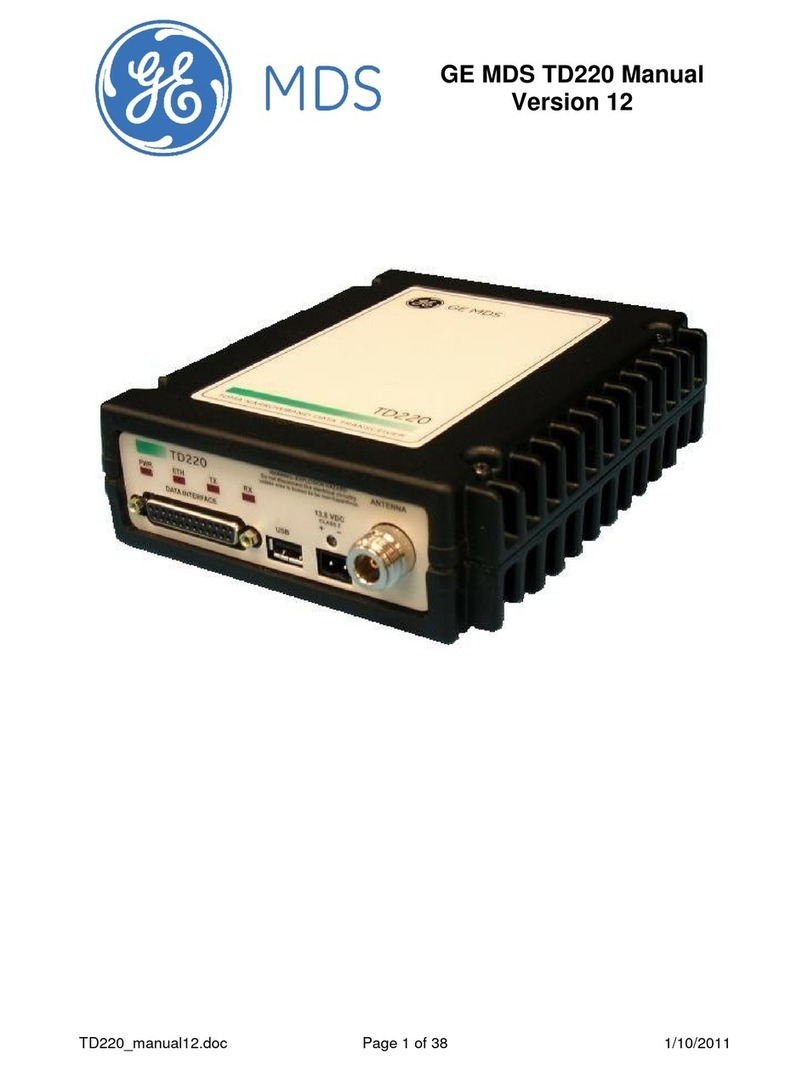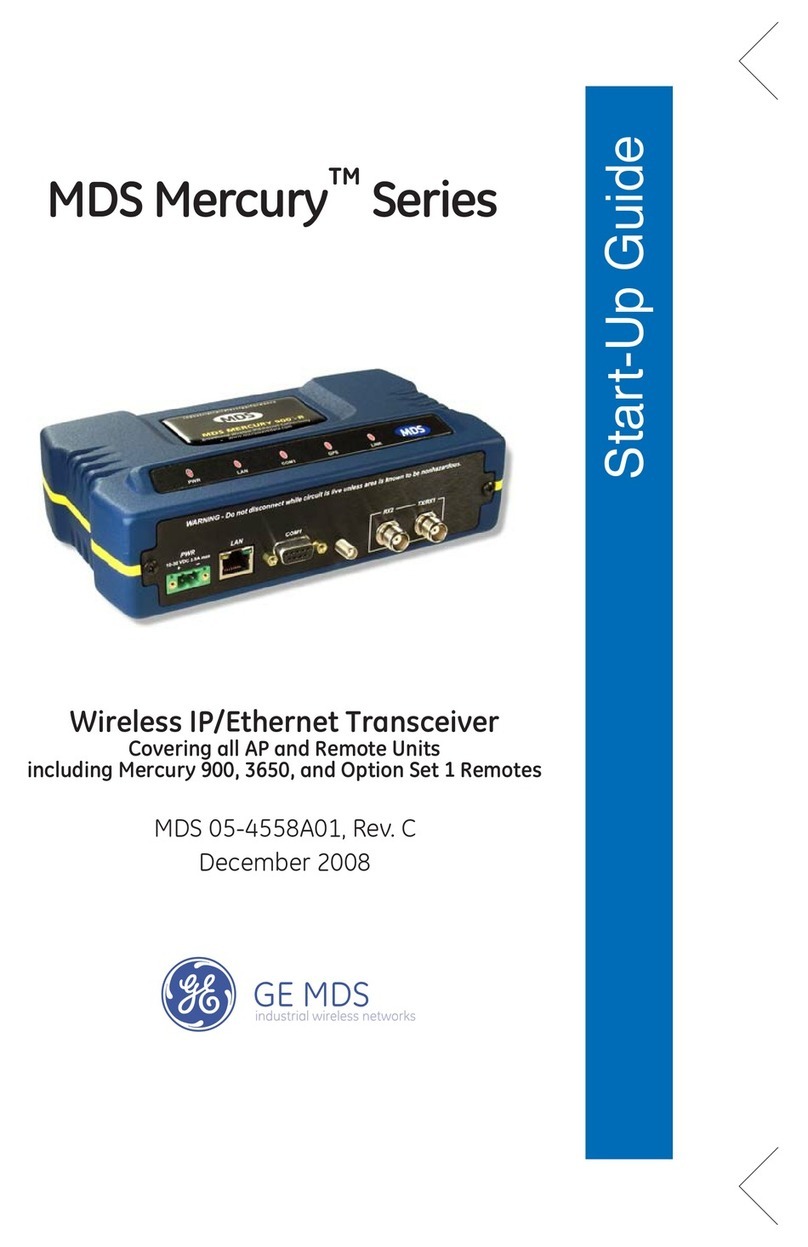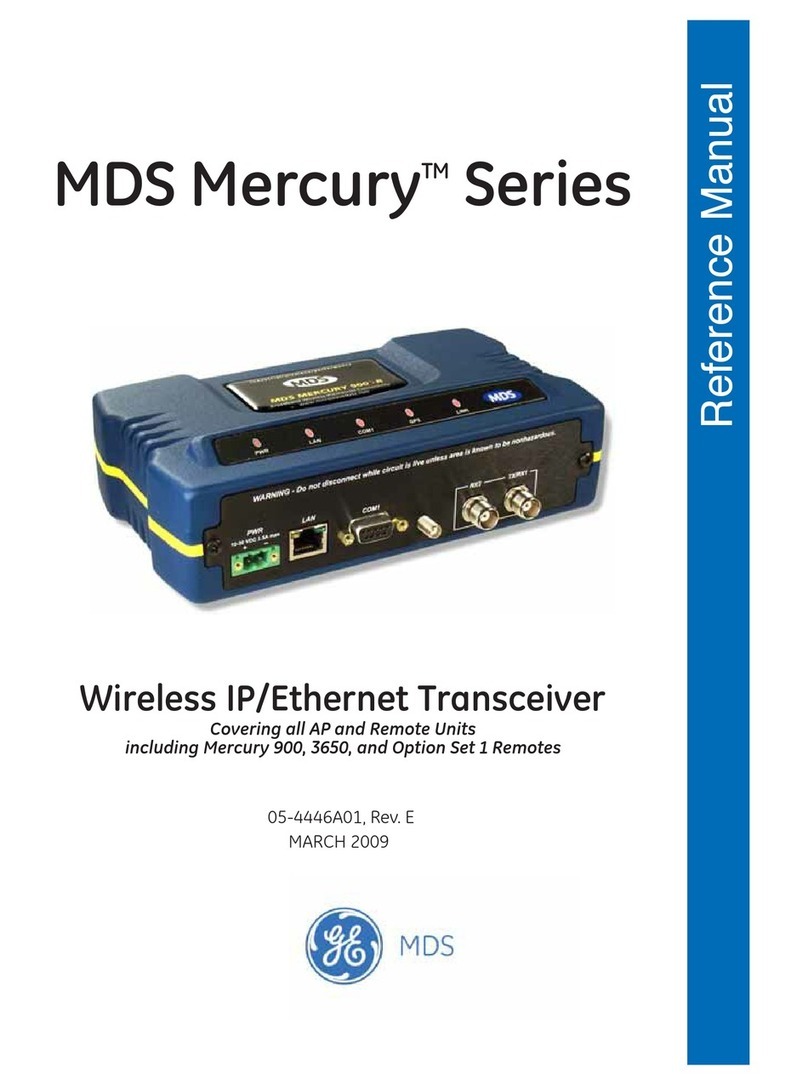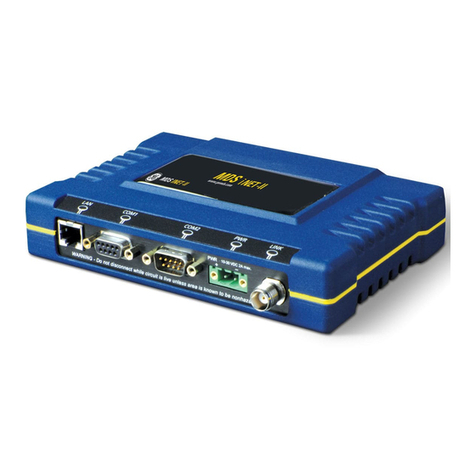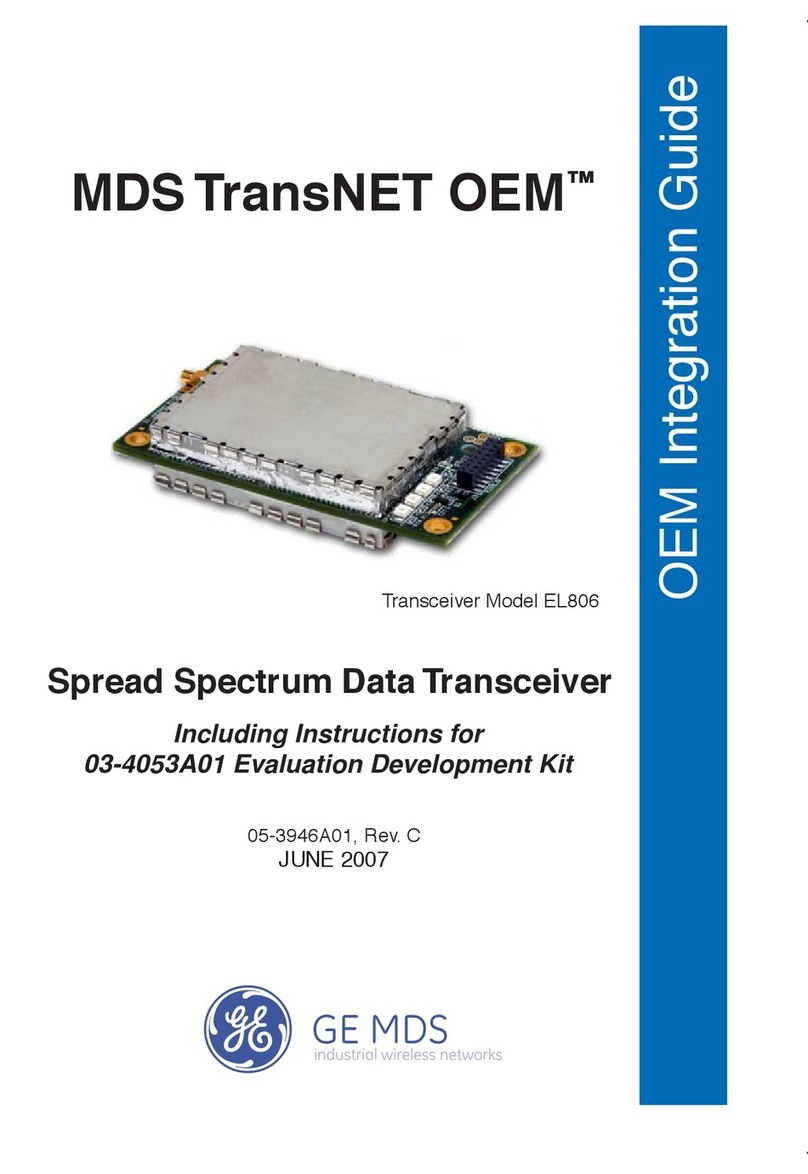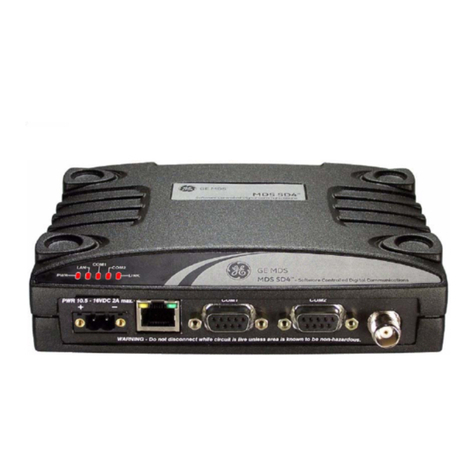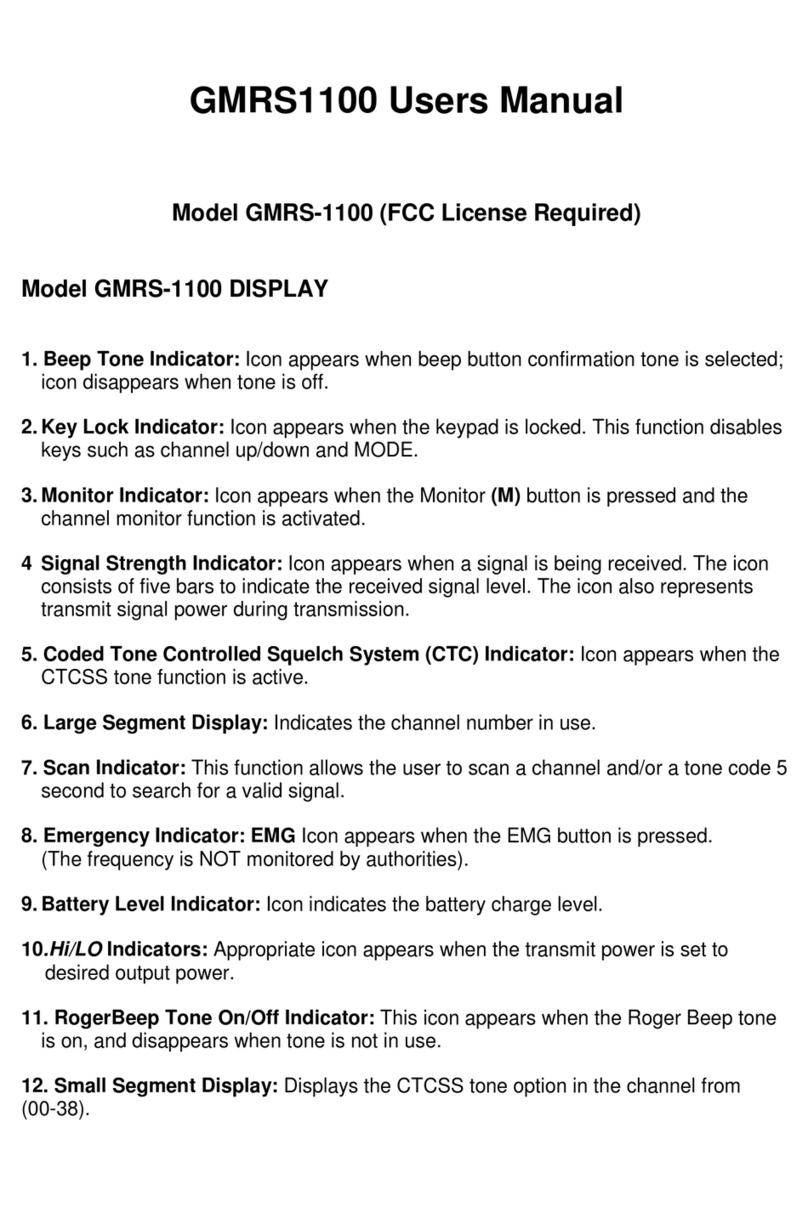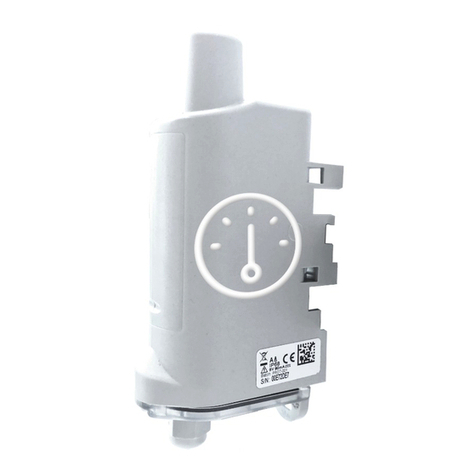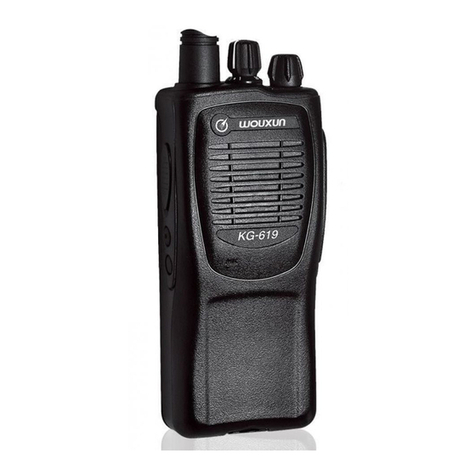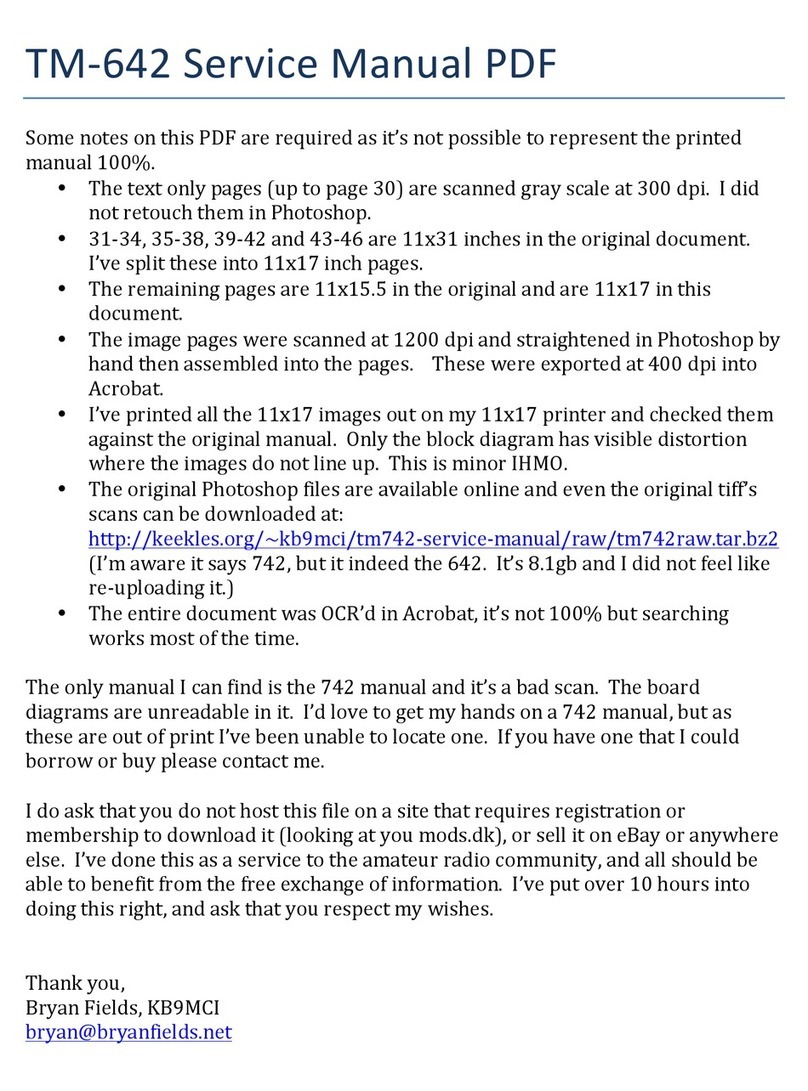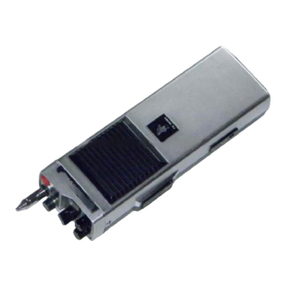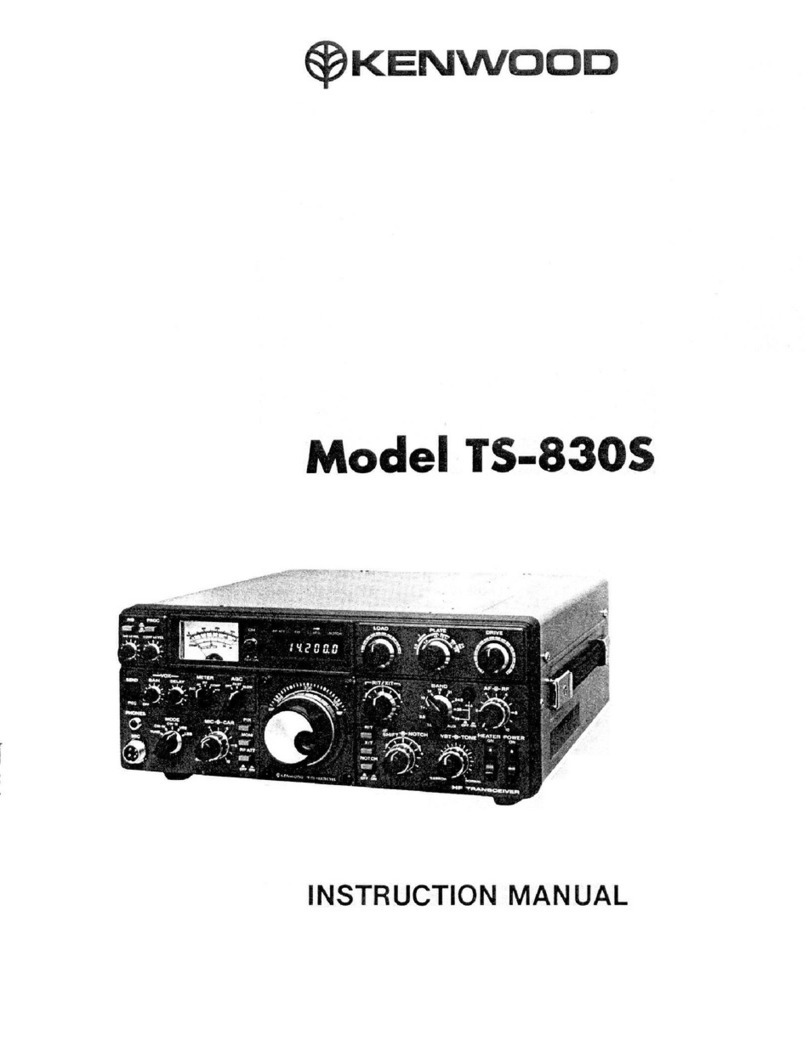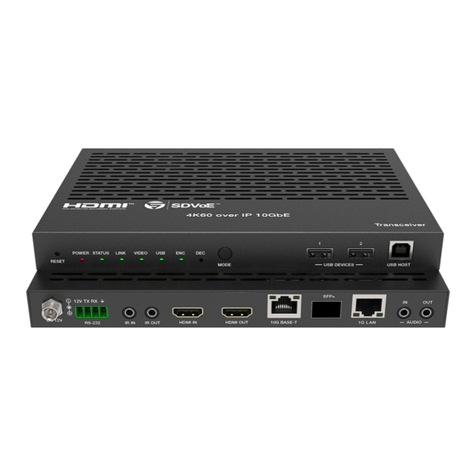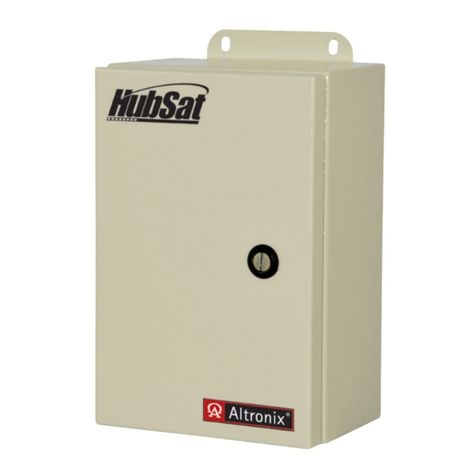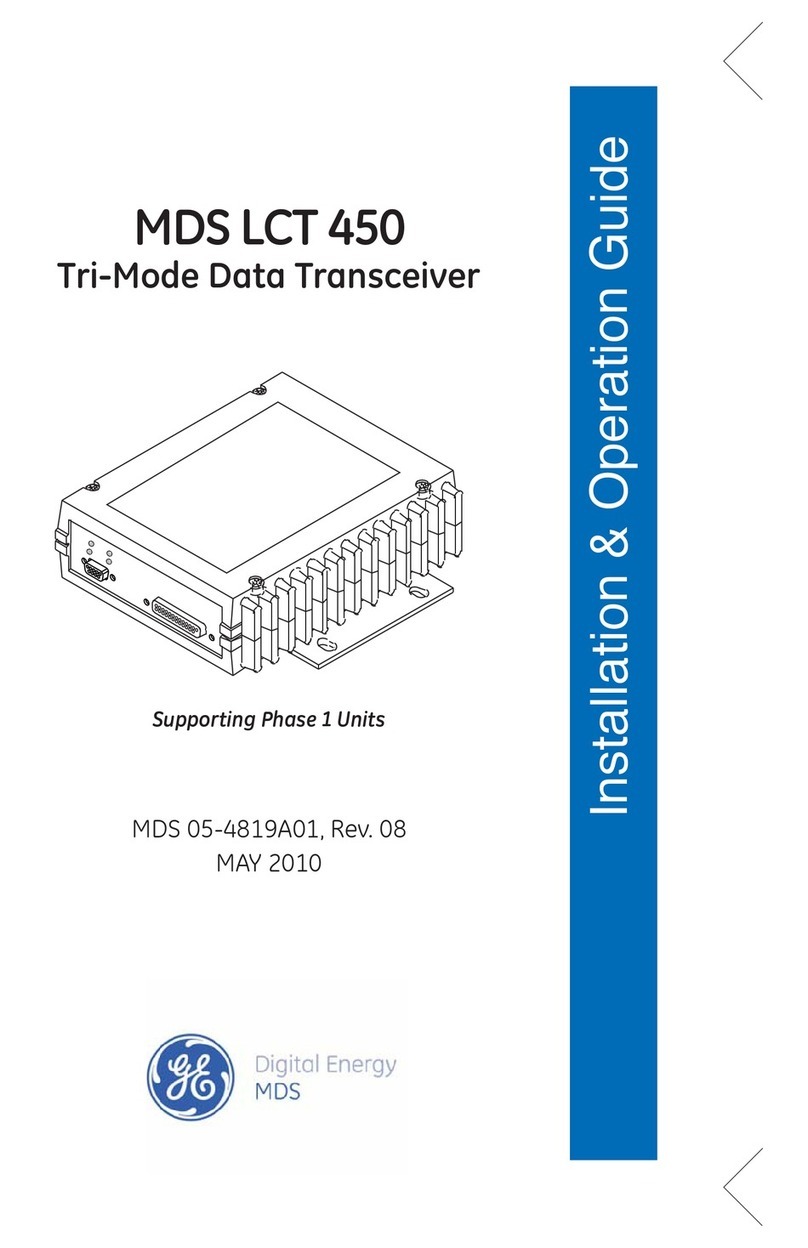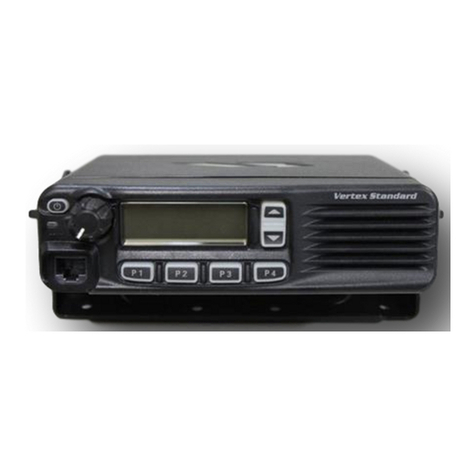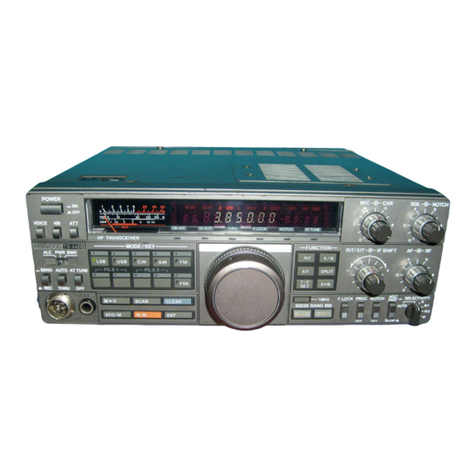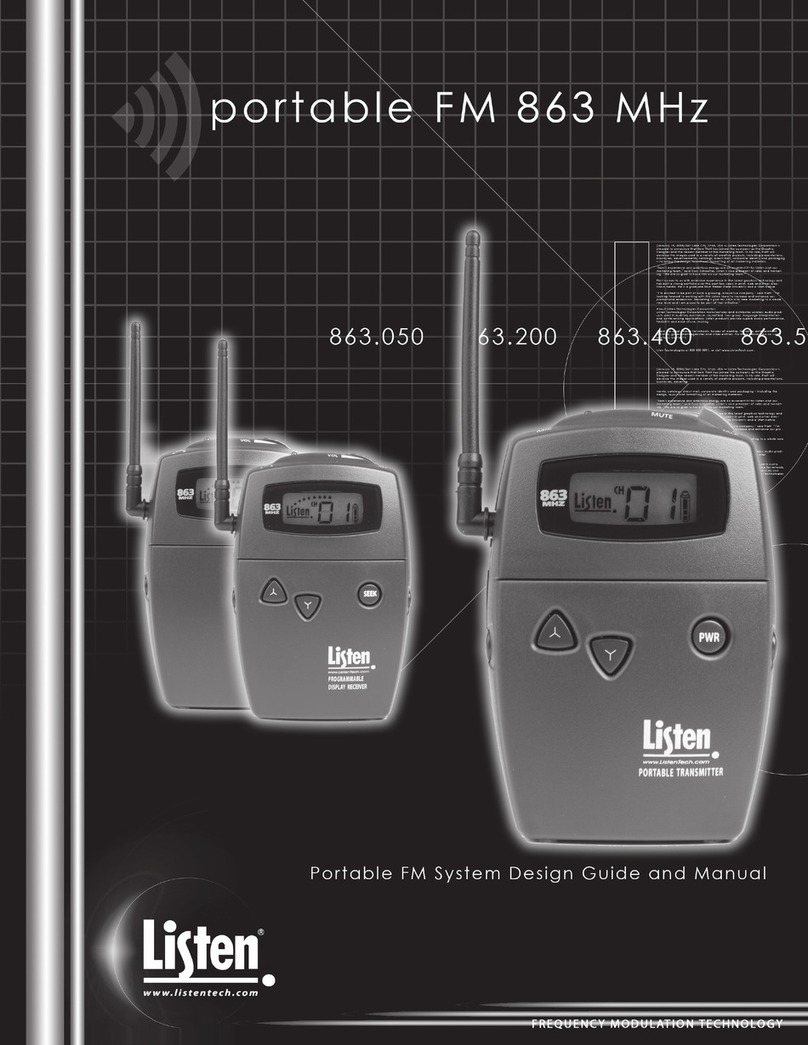GE MDS Mercury 5800 BS User manual

Installation and Operation Guide
Technical Manual
MDS 05-6302A01, Rev. B
Anatel Homologation Manual
FEBRUARY 2012
Mercury 5800 Base Station; Mercury 5800 Subscriber
and Mercury 5800 Outdoor
MDS Mercury Series
Secure, Long Range IP/Ethernet & Serial

Quick-Start instructions for this product are contained in publication 05-6301A01.
All GE MDS user guides are available online at www.gemds.com

MDS 05-6302A01, Rev. B MDS Mercury 16E Technical Manual i
TABLE OF CONTENTS
1.0 PRODUCT DESCRIPTION................................................................................................... 1
1.1 Product Models .............................................................................................................................2
1.2 Key Features .................................................................................................................................3
1.3 Key Specifications .........................................................................................................................3
Accessory Items...............................................................................................................................4
2.0 QUICK-START INSTRUCTIONS.......................................................................................... 5
2.1 Connecting to the Device Manager ...............................................................................................5
2.2 Configure IP Address and Identity .................................................................................................6
2.3 Basic Connectivity .........................................................................................................................7
Setup for Maximum Throughput ......................................................................................................9
3.0 FEATURE DESCRIPTIONS ................................................................................................. 9
3.1 Security Features ..........................................................................................................................9
Overview..........................................................................................................................................9
Authentication................................................................................................................................10
User Authentication........................................................................................................................10
PKMv2 Device Authentication........................................................................................................10
Test Auth Mode (for Bench Test/Evaluation)..................................................................................11
X.509 Certificates...........................................................................................................................11
3.2 Multiple In / Multiple Out (MIMO) Operation ................................................................................11
3.3 ARQ and Hybrid ARQ .................................................................................................................12
ARQ Setup.....................................................................................................................................12
HARQ Setup..................................................................................................................................13
4.0 PERFORMING COMMON TASKS ..................................................................................... 14
4.1 Basic Device Management ..........................................................................................................14
USB Console .................................................................................................................................14
Using Configuration Scripts ...........................................................................................................15
Perform Firmware Upgrade ...........................................................................................................16
Instructions for Completing the Firmware Upgrade Process .........................................................17
Configuring Networking Features for VLAN...................................................................................17
Configure Serial Data Interface for TCP, UDP, MODBUS..............................................................21
Configure QOS ..............................................................................................................................25
Flow Parameters............................................................................................................................26
Quality of Service (QoS) Screen....................................................................................................27
Creating a Service Flow.................................................................................................................28
QOS Example: Low Latency..........................................................................................................28
QOS Example: Controlling Bandwidth in Video Applications.........................................................28
QOS Example: Prioritizing a Data Flow.........................................................................................29
QoS Traffic Shaping.......................................................................................................................31

ii MDS Mercury 16E Technical Manual MDS 05-6302A01, Rev. B
4.2 802.11 Wi-Fi Interface (Optional Feature) ...................................................................................31
802.11 Configuration Options ........................................................................................................32
802.11 Status .................................................................................................................................36
4.3 Radio Test Mode Menu ...............................................................................................................38
4.4 Configure Security Features & Integration with a RADIUS Server ..............................................39
Device Management Interface Configuration.................................................................................39
User Accounts................................................................................................................................40
4.5 RADIUS Server Configuration .....................................................................................................41
Creation of X.509 Certificates........................................................................................................41
Load X.509 Certificates..................................................................................................................41
Configure SNMPV3........................................................................................................................42
4.6 Use of the Antenna Alignment Tool .............................................................................................45
5.0 TROUBLESHOOTING........................................................................................................ 46
5.1 LED INDICATORS .......................................................................................................................46
5.2 WiMAX Statistics .........................................................................................................................46
5.3 Common Troubleshooting Scenarios ..........................................................................................47
6.0 SITE INSTALLATION GUIDE .............................................................................................48
6.1 General Requirements ................................................................................................................48
Mounting Considerations...............................................................................................................49
6.2 Site Selection ..............................................................................................................................50
6.3 Equipment Grounding .................................................................................................................50
6.4 LAN Port ......................................................................................................................................51
6.5 COM1 Port ..................................................................................................................................51
6.6 Antenna & Feedline Selection .....................................................................................................52
Antennas........................................................................................................................................52
Feedlines .......................................................................................................................................53
GPS Cabling & Antenna ................................................................................................................54
6.7 Conducting a Site Survey ............................................................................................................54
6.8 A Word About Radio Interference ................................................................................................54
6.9 Radio (RF) Measurements ..........................................................................................................55
Transmitter Power Output and Antenna System SWR..................................................................55
Antenna Heading Optimization......................................................................................................56
7.0 PERFORMANCE NOTES................................................................................................... 57
7.1 Wireless Bridge ...........................................................................................................................57
7.2 Distance-Throughput Relationship ..............................................................................................58
7.3 Data Latency—TCP versus UDP Mode ......................................................................................58
7.4 Packets-per-Second (PPS) .........................................................................................................58
7.5 Subscriber-to-Subscriber Traffic ..................................................................................................58
7.6 Interference has a Direct Correlation to Throughput ...................................................................59
7.7 Placing the Radio Behind a Firewall ............................................................................................59
8.0 INDEX OF CONFIGURATION PARAMETERS................................................................... 60

MDS 05-6302A01, Rev. B MDS Mercury 16E Technical Manual iii
9.0 dBm-WATTS-VOLTS CONVERSION CHART....................................................................76
Band History ..................................................................................................................................77
Technical Details............................................................................................................................77
Exclusion Zones.............................................................................................................................77
APPENDIX A—3650 MHz Band Information..............................................................................77
APPENDIX B—Glossary of Terms & Abbreviations.................................................................... 79
Copyright and Trademark
This manual and all software described herein is protected by Copyright: 2012 GE MDS, LLC. All
rights reserved. GE MDS, LLC reserves its right to correct any errors and omissions in this
publication. Modbus® is a registered trademark of Schneider Electric Corporation. All other
trademarks and product names are the property of their respective owners.
FCC Part 15 Notice
The transceiver series complies with Part 15 of the FCC Rules for a Class A digital device.
Operation is subject to the following two conditions: (1) this device may not cause harmful
interference, and (2) this device must accept any interference received, including interference that
may cause undesired operation. Any unauthorized modification or changes to this device without
the express approval of GE MDS may void the user’s authority to operate this device. Furthermore,
the Mercury Series is intended to be used only when installed in accordance with the instructions
outlined in this guide. Failure to comply with these instructions may void the user’s authority to
operate the device.
Industry Canada Notice
Industry Canada rules (SRSP 301.7) require that the power to the antenna on an 1800-1830 MHz
installation shall not exceed 2 watts in any 1 MHz channel bandwidth.
RF Exposure Notices (English and French)
1800 MHz Models
Professional installation required. The radio equipment described in this guide emits radio
frequency energy. Although the power level is low, the concentrated energy from a directional
antenna may pose a health hazard. Do not allow people to come closer than 0.4 meters (15 inches)
to the antenna when the transmitter is operating in indoor or outdoor environments. More
information on RF exposure is available on the Internet at
www.fcc.gov/oet/info/documents/bulletins.

iv MDS Mercury 16E Technical Manual MDS 05-6302A01, Rev. B
L'énergie concentrée en provenance d'une antenne directionnelle peut présenter un danger pour la
santé. Ne pas permettre aux gens de s'approcher à moins de 0.4 metres à l'avant de l'antenne lorsque
l'émetteur est en opération. On doit augmenter la distance proportionnellement si on utilise des
antennes ayant un gain plus élevé. Ce guide est destiné à être utilisé par un installateur
professionnel. Plus d'informations sur l'exposition aux rayons RF peut être consulté en ligne à
l'adresse suivante: www.fcc.gov/oet/info/documents/bulletins
3650 MHz Models
Professional installation required. The transceiver described here emits radio frequency energy.
Although the power level is low, the concentrated energy from a directional antenna may pose a
health hazard. Do not allow people to come closer than 25 cm (9.8 inches) to the antenna when the
transmitter is operating. This calculation is based on an 18 dBi panel antenna. Additional
information on RF exposure is available on the Internet at
www.fcc.gov/oet/info/documents/bulletins.
L'énergie concentrée en provenance d'une antenne directionnelle peut présenter un danger pour la
santé. Ne pas permettre aux gens de s'approcher à moins de 25 cm à l'avant de l'antenne lorsque
l'émetteur est en opération. On doit augmenter la distance proportionnellement si on utilise des
antennes ayant un gain plus élevé. Ce guide est destiné à être utilisé par un installateur
professionnel. Plus d'informations sur l'exposition aux rayons RF peut être consulté en ligne à
l'adresse suivante: www.fcc.gov/oet/info/documents/bulletins.
5800 MHz Models
Professional installation required. The radio equipment described in this guide emits radio
frequency energy. Although the power level is low, the concentrated energy from a directional
antenna may pose a health hazard. Do not allow people to come closer than 0.2 meters (8 inches)
to the antenna when the transmitter is operating in indoor or outdoor environments. More
information on RF exposure is available on the Internet at
www.fcc.gov/oet/info/documents/bulletins.
L'énergie concentrée en provenance d'une antenne directionnelle peut présenter un danger pour
lasanté. Ne pas permettre aux gens de s'approcher à moins de 0.2 metres à l'avant de l'antenne
lorsque l'émetteur est en opération. On doit augmenter la distance proportionnellement si on utilise
des antennes ayant un gain plus élevé. Ce guide est destiné à être utilisé par un installateur
professionnel. Plus d'informations sur l'exposition aux rayons RF peut être consulté en ligne à
l'adresse suivante: www.fcc.gov/oet/info/documents/bulletins
FCC Co-location Requirements: To meet FCC co-location requirements for transmitting
antennas, a 20 cm (7.87 inch) separation distance is required between the unit’s Wi-Fi and funda-
mental antennas.
Servicing Precautions
When servicing energized equipment, be sure to wear appropriate Personal Protective Equipment
(PPE). During internal service, situations could arise where objects accidentally contact or short
circuit components and the appropriate PPE would alleviate or decrease the severity of potential
injury. When servicing radios, all workplace regulations and other applicable standards for live
electrical work should be followed to ensure personal safety.

MDS 05-6302A01, Rev. B MDS Mercury 16E Technical Manual v
Ethernet and Serial Cables
The use of shielded Ethernet and serial cables are required to ensure EMC compliance when
operating this equipment.
Manual Revision and Accuracy
This manual was prepared to cover a specific version of firmware code. Accordingly, some screens
and features may differ from the actual unit you are working with. While every reasonable effort
has been made to ensure the accuracy of this publication, product improvements may also result in
minor differences between the manual and the product shipped to you. If you have additional
questions or need an exact specification for a product, please contact GE MDS using the
information at the back of this guide. In addition, manual updates can often be found on our web
site at www.gemds.com.
Environmental Information
The manufacture of this equipment has required the extraction and use of natural resources.
Improper disposal may contaminate the environment and present a health risk due to hazardous
substancescontained within. To avoiddissemination ofthese substances into our environment, and
to limit the demand on natural resources, we encourage you to use the appropriate recycling
systems for disposal. These systems will reuse or recycle most of the materials found in this
equipment in a sound way. Please contact GE MDS or your supplier for more information on the
proper disposal of this equipment.
Battery Disposal—This product may contain a battery. Batteries must be disposed of properly, and
may not be disposed of as unsorted municipal waste in the European Union. See the product
documentation for specific battery information. Batteries are marked with a symbol, which may
include lettering to indicate cadmium (Cd), lead (Pb), or mercury (Hg). For proper recycling return
the battery to your supplier or to a designated collection point. For more information see:
www.weeerohsinfo.com.
Product Test Data Sheets
Test Data Sheets showing the original factory test results for this unit are available upon request
from the GE MDS Quality Leader. Contact the factory using the information at the back of this
manual. Serial numbers must be provided for each product where a Test Data Sheet is required.

vi MDS Mercury 16E Technical Manual MDS 05-6302A01, Rev. B

MDS 05-6302A01, Rev. B MDS Mercury 16E Technical Manual 1
1.0 PRODUCT DESCRIPTION
The GE MDS Mercury SeriesTM transceiver is an easy-to-install
WiMAX solution offering extended range, secure operation, and
multi-megabit performance in a compact and rugged package. Mercury
isideally suited forwireless data applicationsin Smart GridElectric,Oil
and Gas, Water/Wastewater, and other industrial uses in fixed locations
where range, reliability, throughput, and security are paramount.
Figure 1. Mercury MIMO Series Transceiver
(Top: Base Station, Bottom: Subscriber Unit)
The transceivers are commonly used to convey SCADA traffic,
automated metering, distribution automation, command and control
traffic, text documents, graphics, e-mail, video, Voice over IP (VoIP),
and a variety of other application data between field devices and
WAN/LAN-based entities.
Based on multi-carrier Orthogonal Frequency Division Multiplexing
(OFDM), the transceiver features high speed/low latency, Quality of
Service (QoS), Ethernet and serial encapsulation, and MIMO
(multiple-input and multiple output)-enhanced performance. It also
provides enhanced security including 128-bit AES encryption and
EAP-TLSIEEE 802.1xDevice Authentication. These features make the
Mercury system the best combination of security, range, and speed of
any industrial wireless solution on the market today.

2 MDS Mercury 16E Technical Manual MDS 05-6302A01, Rev. B
For installation and setup instructions for these products, please refer to
GE MDS publication 05-6301A01.
1.1 Product Models
The Mercury transceiver is available in several different product
models:
• The indoor Base Station (BS) acts as the center of each
point-to-multipoint network. It has two RJ-45 Ethernet ports
and a DB-9 RS-232 serial port for data connections.
• The indoor Subscriber Unit (SU) acts as one of the multipoints
in the network. It also has two RJ-45 Ethernet ports and a DB-9
RS-232 serial port for data connections.
• The Outdoor Subscriber Unit (ODU) is a weatherproof ver-
sion of the standard Subscriber Unit. The ODU has one RJ-45
Ethernet port and a DB-9 serial port for data connections.
Invisible place holder
Figure 2. Outdoor Subscriber Unit (ODU)
(Back of unit, showing interface connectors)
The key features and options for the various models are listed in Table 1
below.
Table 1. Mercury Models and Interfaces
Interfaces Base Station Indoor Subscriber Outdoor Subscriber
Ethernet
ports 2 RJ-45 Ethernet
with built-in Layer 2
switch
2 RJ-45 Ethernet with built-in
Layer 2 switch 1 RJ-45 Ethernet. May be
ordered as Power over Ethernet
or AC model
Serial
port 1 DB-9 RS-232 1 DB-9 RS-232 1 DB-9 RS-232
USB 1 USB host port
1 USB device port 1 USB host port
1 USB device port 1 USB host port
WiMAX Dual TNC for MIMO
(1800 and 3650
models)
DualSMAfor MIMO
(5800 model)
Dual TNC for MIMO
(1800 and 3650 models)
Dual SMA for MIMO (5800
model)
Internal RF connections
GPS Internal receiver
with SMA connector Optional internal receiver with
SMA connector None

MDS 05-6302A01, Rev. B MDS Mercury 16E Technical Manual 3
1.2 Key Features
The Mercury transceiver supports:
• WiMAX IEEE 802.16e-2005 interoperability
• Scalable OFDM using 512 or 1024 subcarriers
• 2x2 MIMO on all models supporting Matrix A and Matrix B
Space Time Coding, Spatial Multiplexing, Maximum Ratio
Combining, and Maximum Likelihood Detection
• PKMv2 security including AES-CCMP 128-bit encryption,
EAP-TLS, and X.509 digital certificates
• Hybrid ARQ up to Category 4
• Adaptive modulation from QPSK with 1/2-rate FEC coding to
64-QAM with 5/6-rate coding
• Quality of Service (QoS) including:
• Unsolicited Grant Service (UGS), Real-time polling service
(RTPS), Non-real-time polling service (nRTPS), Enhanced
real-time polling service (eRTPS), Best Effort (BE)
• Wi-Fi service available as an option for ODU and Subscriber
units
• SNMP MIB support: MIB-II, GE MDS Proprietary, WiMAX*
* Expected availablity 2012
1.3 Key Specifications
Table 2 lists key operational specifications for the Mercury Transceiver.
Antenna External External 15 dBi panel ant. for 1800 model
18 dBi panel ant. for 3650 model
18 dBi panel ant for 5800 model
Wi-Fi -- Optional reverse SMA
connector Optional reverse SMA connector
Table 1. Mercury Models and Interfaces (Continued)
Table 2. Key Specifications
Primary Wireless IEEE 802.16E-2005 WiMAX
Local Interfaces
(indoor models) Two channel WiMAX, TNC connectors (1800, 3650 models)
Two channel WiMAX, SMA connectors (5800 model)
Dual 10/100 Ethernet, RJ-45, auto-sense, auto-mdix
DB9 Serial Port
USB host and device ports
GPS receiver, SMA connector (Optional on Subscriber)
Wi-Fi, Reverse SMA connector
Local Interfaces
(ODU models) (1) 10/100 Ethernet, RJ-45, auto-sense, auto-mdix
DB-9 Serial Port
USB Host Port

4 MDS Mercury 16E Technical Manual MDS 05-6302A01, Rev. B
Accessory Items
GE MDS can provide accessory items for use with the Transceiver,
including the items listed below:
• Antennas—Omni and directional types
• USB cable, CAT5, serial DB9s
• RF coaxial cable, connectors
Frequency Bands 1800 to 1830 MHz (Industry Canada)
3650 to 3675 MHz (FCC, Industry Canada)
5725 to 5825 MHz (FCC)
Frequency step size 250 kHz
Bandwidth 3.5, 5, 7, 8.75, and 10 MHz
Wi-Fi (optional) 2.4 GHz, 802.11b/g protocol
RF Power Output 1800 and 3650 models: 30 dBm for all units, except 23 dBm
for 3650 ODU
5800 model: +18.0 dBm for ODU; 17.7 dBm for indoor units
(limited for FCC compliance)
TransmitterDynamic
Range 60 dB, 1 dB step size
Antenna 1800 Subscriber: 15 dBi panel, dual-polarized
1800 Base Station: 12 dBi sector, dual-polarized, 120o
beamwidth
3650 Subscriber: 18 dBi panel, dual-polarized
3650 Base Station: 14 dBi sector, dual-polarized, 120o
beamwidth
5800 Subscriber: 18 dBi panel, dual-polarized
5800 Base Station: 16 dBi sector, dual-polarized, 90o
beamwidth
Input Power Indoor units: 10 to 60 VDC
Outdoor units:
Power over Ethernet
10 to 60 Vdc
110/220 Vac
Power Consumption
(average ratings) 1800 Base: 17 Watts
1800 Subscriber: 10 Watts
1800 ODU: 10 Watts
3650 Base: 13 Watts
3650 Subscriber: 8 Watts
3650 ODU: 8 Watts
5800 Base: 14 Watts
5800 Subscriber: 9 Watts
5800 ODU: 9 Watts
Operating
Temperature -30 to +70 degrees C
Unit Dimensions
(excluding
connectors)
Indoor Base/Subscriber:
4.5 x 7.75 x 2.75 inches (11.43 x 19.69 x 6.99 cm)
ODU: 14.5 x 14.5 x 4.5 inches (37 x 37 x 11.5 cm)
Table 2. Key Specifications (Continued)

MDS 05-6302A01, Rev. B MDS Mercury 16E Technical Manual 5
2.0 QUICK-START INSTRUCTIONS
2.1 Connecting to the Device Manager
The Mercury transceiver contains a built-in web server, known as the
Device Manager, for configuration and diagnostics. Each transceiver
needs to have some basic configuration parameters set before placing
the unit in service. To start the Device Manager, connect an Ethernet
cable from the Mercury to the PC used for configuration. The radio’s
Ethernet interfaces have auto-sense detection allowing a
straight-through or crossover cable to be used.
NOTE: The PC used for radio management must be in the radio’s
default IP Subnet for communications to take place. It can be
changed once the desired IP address is chosen.
To manage the radio, start a web browser and enter the unit’s IP address.
The transceiver defaults to an IP address 192.168.1.1 and netmask
255.255.255.0. The Mercury will prompt for a username and password.
The default entries for both of these fields are admin.
NOTE: In case of a lost password and an inability to login, see
“Common Troubleshooting Scenarios” on Page 47 for details
on resetting the password and the unit's configuration.
Once connected to the Device Manager, the summary page shown in
Figure 3 is displayed.
Invisible place holder
Figure 3. Mercury Summary Page Example
(Shows connection after IP address has been changed)

6 MDS Mercury 16E Technical Manual MDS 05-6302A01, Rev. B
2.2 Configure IP Address and Identity
The IP Address of the unit is configured on the Configuration - IP &
Networking page. The IP address and netmask should be set according to
the network configuration defined by the system administrator. Note
that if the IP address is changed, the web browser session will need to
be re-started with the new configuration.
Invisible place holder
Figure 4. Mercury Configuration-IP & Networking
In addition to the IP address, the unit can be configured with an optional
Device Name for ease of administration. The name can be set on the
Configuration - Identity & Time page.
Invisible place holder
Figure 5. Mercury Configuration —Identity & Time

MDS 05-6302A01, Rev. B MDS Mercury 16E Technical Manual 7
2.3 Basic Connectivity
Toestablishbasic connectivity betweenaBase Station anda Subscriber,
start the configuration with the Base Station. The IP address and Device
Name will be as set from the factory (or by the previous user). With a
factory-fresh unit, the Device Name will blank. The Configuration - Radio
page contains the key parameters for configuring the WiMAX interface.
Invisible place holder
Figure 6. Mercury Configuration—Radio
For3650units,the frequency defaults to 3662.5MHzand the bandwidth
is set to 3.5 MHz. These default values are sufficient to perform
benchtop testing prior to final installation. Set the frequency and
bandwidth to the same values on the Base Station and Subscriber. If
performing the test on a table, cable the units as shown in Figure 7. The
attenuator cables should be connected to the radio’s TX/RX connectors.
NOTE: The frequency default for the 1800 model is 1815 MHz. For
the 5800 model it is 5800 MHz. Not all frequencies can be
configured for each bandwidth. Ranges differ.

8 MDS Mercury 16E Technical Manual MDS 05-6302A01, Rev. B
Invisible place holder
Figure 7. Benchtop Test Setup
Use the Maintenance & Status - Performance page on the Subscriber to
monitor the establishment of the link.
Invisible place holder
Figure 8. Maintenance and Status Screen
The WiMAX Network Status will display a Connection Status of
OPERATIONAL when the Subscriber is successfully linked to the Base
Station. This pane also displays the signal strength and quality. For a
cabled, benchtop test, an RSSI of -70 dBm is acceptable. For a -70 dBm
signal, a signal-to-noise ratio (SNR) of 28 dB or greater is expected.

MDS 05-6302A01, Rev. B MDS Mercury 16E Technical Manual 9
Setup for Maximum Throughput
To demonstrate maximum throughput, several configuration changes
must be made. In addition, the link needs to be cabled according to
Figure 7, with a strong signal, that is, above -70 dBm. If necessary, the
link attenuation should be adjusted to reach the desired RSSI level. The
transmit power of the Base Station should be reduced to 10 dBm to
ensure that the Subscriber only receives the signal through the cables
and not directly from enclosure to enclosure.
With this strong signal the modulation rate downlink and uplink should
be 64QAM FEC 5/6. There may need to be data flow, such as an ICMP
ping, in order to have the modems shift up to this modulation rate. Both
the Base Station and Subscriber need to be set for MIMO Type Matrix
A/B. The Base Station should have HARQ (4) enabled and ARQ
disabled. These changes are made using the Configuration - Radio page.
This setup and configuration can be used with any RF bandwidth.
Approximate aggregate throughput for each bandwidth is given below.
* 28 Mbps aggregate throughput was attained at 64QAM FEC 5/6, 10 Mhz bandwidth
and rev. 2.0.4 product firmware.
3.0 FEATURE DESCRIPTIONS
3.1 Security Features
Overview
The Mercury transceiver employs many security features to keep the
device, network, and data secure. Some of these features include
WiMAX PKMv2, EAP-TLS, and AES-CCMP encryption on the
WiMAX interface and HTTPS, SNMPv3, and RADIUS authentication
for the configuration interfaces.
Table 3. Throughput Ratings (Nominal)
Bandwidth Aggregate
Throughput
3.5 MHz 7 Mbps
5 MHz 10 Mbps
7 MHz 15 Mbps
8.75 MHz 16 Mbps
10 MHz 28 Mbps*

10 MDS Mercury 16E Technical Manual MDS 05-6302A01, Rev. B
Authentication
Authentication is the process by which one network entity verifies that
another entity is who or what it claims to be and has the right to join the
network and use its services. Authentication in wireless SCADA
networks has two primary forms: User Authentication and Device
Authentication. User authentication allows a device to ensure that a user
may access the device's configuration and services. Device
authentication allows a network server to verify that a hardware device
may access the network.
User Authentication
The Mercury transceiver requires user login with an account and
password in order to access the Device Manager menu. This process can
be managed locally in which the device stores the user account
information in its on-board non-volatile memory, or remotely in which
a RADIUS server is used. The transceiver has two local accounts:
operator and admin. The operator account has read-only access to
configuration parameters and performance data. The admin account has
read-write access to all parameters and data.
NOTE: The Operator account has access through the web, console,
Telnet, or SSH interfaces, but settings may only be viewed, not
changed.
To centralize the management of user accounts, a RADIUS server may
be used. Each Mercury transceiver must be configured with the IP
address, port, shared secret, and authentication protocol of a RADIUS
server. When a user attempts to login, the credentials are forwarded to
the RADIUS server for validation.
PKMv2 Device Authentication
The IEEE 802.16e-2005 WiMAX standard uses PKMv2 for securing
the wireless channel. PKMv2 stands for Privacy Key Management
version 2. The Privacy Key Management protocol is used to exchange
keying material from the Base Station to the Subscriber. This keying
material is used to encrypt data so that it is secure during transport over
the air. The encryption keys are routinely rotated to ensure security.
Initial keying material is obtained during the device authentication
process. This occurs when a Subscriber attempts to join a Base Station.
The Base Station initiates an EAP-TLS negotiation with the Subscriber
to begin the device authentication process. The Subscriber is only
allowed to transmit EAP messages until the authentication has finished
successfully. The Base Station forwards messages to the RADIUS
server where the decision to allow the Subscriber to join is made. If the
Subscriber authenticates successfully and the RADIUS server allows

MDS 05-6302A01, Rev. B MDS Mercury 16E Technical Manual 11
the Subscriber to join the network, then the data encryption keying
material is sent to the Base Station. The Base Station then continues the
PKM protocol to further derive keying material that is used to secure
transmissions between the Base Station and the Subscriber.
The Subscriber must be configured with X.509 certificates that are
appropriate for the Public Key Infrastructure (PKI) in which they are
deployed. These certificates are used to identify and authenticate the
Subscriber to the RADIUS sever.
Test Auth Mode (for Bench Test/Evaluation)
The Device Auth Mode can be set to Test Auth to enable encryption on
the WiMAX link without requiring an AAA server. To use this mode,
both the Base Station and the Subscriber(s) must be set to Test Auth. In
this arrangement, the Base Station acts as a simple AAA server and
authenticates the subscriber without actually evaluating its identity
certificate. This is convenient when doing bench testing in which the
performance with encryption enabled is to be measured but without the
complexity of setting up a AAA server and identity certificates.
X.509 Certificates
A digital certificate, also known as an X.509 certificate, is a file that
contains identification data and asymmetric key material. Each
certificate contains a Common Name that identifies the user or device
thatownsthe certificate. Theprimaryinformationinthe certificate isthe
public key for the user or device and a digital signature proving the
authenticity of the certificate's contents.
The Mercury transceiver uses X.509 certificates in the EAP-TLS
handshake during device authentication as described in the PKMv2
section above.
NOTE: Certificates must start with the serial number of the radio to
work.
3.2 Multiple In / Multiple Out (MIMO) Operation
MIMO stands for Multiple In / Multiple Out. The Mercury transceiver
features 2x2 MIMO on all models. This means that there are two full
transmit and receive channels on each device. The use of 2x2 MIMO
causes the Mercury transceiver to have higher throughput and greater
range and coverage than single channel devices in the same
environment.

12 MDS Mercury 16E Technical Manual MDS 05-6302A01, Rev. B
There are two operating modes that the Mercury supports. The first
mode is Matrix A in which the Mercury uses Space-Time Coding (STC)
on the transmitter to allow it to send the same data on each channel but
coded differently in order to get transmit diversity. On the receive side,
the Mercury transceiver uses Maximum Ratio Combining (MRC) to
more accurately reconstruct the received signal by using both receive
channels.
The second mode is Matrix B in which the Mercury uses Spatial
Multiplexing (SM) to send different data flows on each channel
allowing it to effectively double the amount of data transmitted. The
Mercury offers a Matrix A/B setting in which the transceivers determine
in real time which mode, Matrix A or Matrix B, to use according to the
channel conditions. This determination is made based on the SNR and
Packet Error Rate (PER).
GE MDS sells antennas that are dual-polarized for MIMO applications.
This includes sector antennas for Base Stations and panel antennas for
Subscribers. Each antenna has two feed lines, one for the vertically
polarized element, and one for the horizontally polarized element.
3.3 ARQ and Hybrid ARQ
Automatic Retransmission Request (ARQ) enables retransmission of
erroneous or lost data packets. Hybrid ARQ (HARQ) combines forward
error correction with ARQ retransmissions to improve performance at
lower RF signal levels.
With ARQ, the receiver discards erroneous packets and requests
retransmission. With HARQ, erroneous packets are saved by the
receiver and combined with the retransmitted data. Generally, HARQ
provides better throughput than ARQ. While ARQ and HARQ can be
enabled at the same time, it is not recommended to do so because
throughput will be less than if either ARQ or HARQ was enabled on its
own.
ARQ and HARQ can be enabled or disabled in the ARQ/HARQ Settings
table of the Configuration-Radio page on the Base Station.
ARQ Setup
ARQ utilizes a sliding window approach where a “window” of blocks
can be transmitted without receiving acknowledgement from the
receiver. ARQ blocks that are unacknowledged will be resent. You can
specify the block and window size at the Base Station, as well as Block
Lifetime, Transmitter Delay, and Receiver Delay.
• ARQ Block Size - The size, in bytes, of the block of data to be
considered for retransmission.
This manual suits for next models
2
Table of contents
Other GE MDS Transceiver manuals
